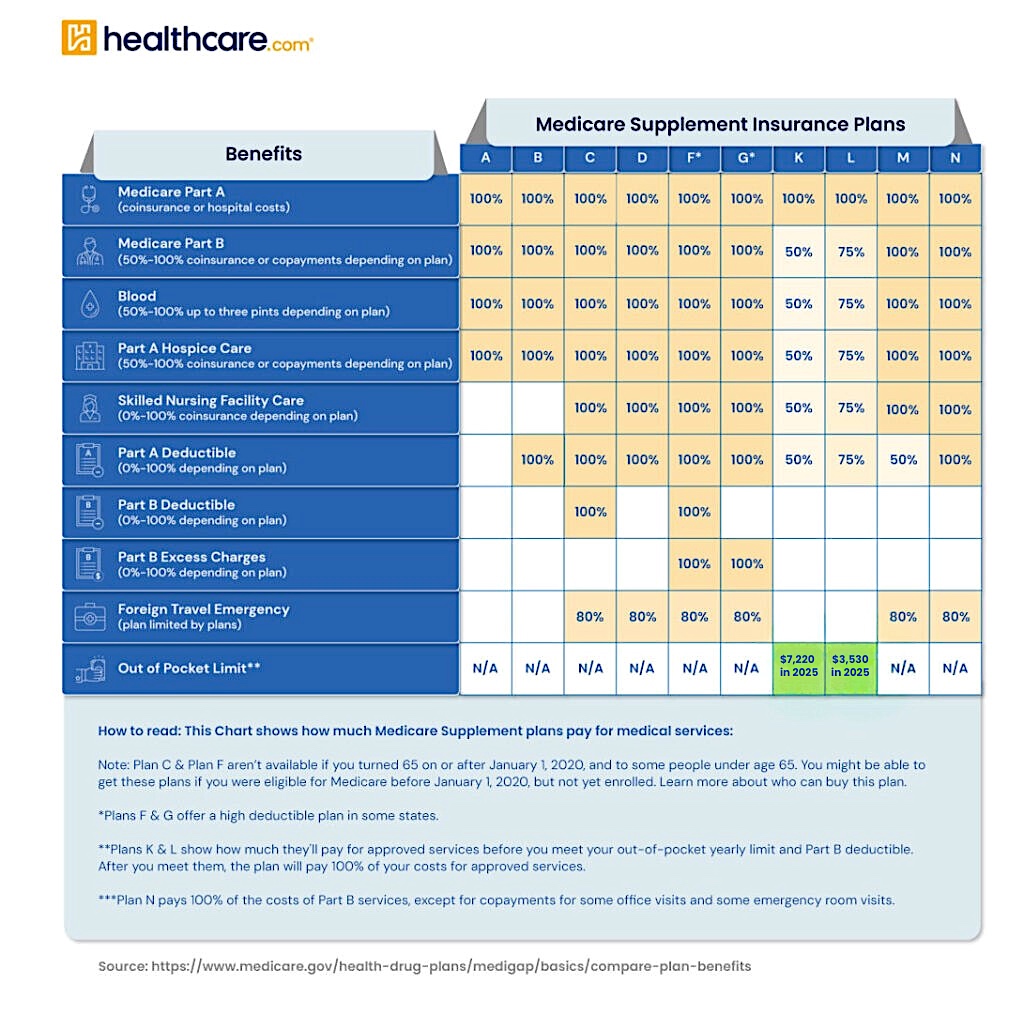Written by Tara Seboldt
HealthCare Writer
We aim to help you make informed healthcare decisions. While this post may contain links to lead generation forms, this won’t influence our writing. We follow strict editorial standards to give you the most accurate and unbiased information.
What You Need to Know
- Medicare Supplement plans, also known as Medigap, help pay for out-of-pocket costs not covered by Medicare Part A and Part B.
- Texas insurance companies must accept your Medicare Supplement (Medigap) plan application if you’re in your Medigap Open Enrollment Period or have guaranteed issue rights.
- The three most popular Medigap policies are typically Plans F, G, and N.
What Are Medicare Supplement Plans in Texas?
Medicare is a federal health insurance program for individuals aged 65 and older, as well as younger people with qualifying disabilities or health conditions (e.g., end-stage renal disease).
Original Medicare, which includes Part A (Hospital Insurance) and Part B (Medical Insurance), covers many healthcare services. However, it still leaves you with out-of-pocket costs like deductibles, coinsurance, and copayments. Medicare Supplement plans help pay for these expenses.
Medigap plans are standardized by letter (A through N). That means Plan A from one company offers the same benefits as Plan A from another, though premiums may differ.
Learn how these plans work and how they benefit residents of Texas.
Compare options HERE & start your health plan journey.
When Can You Enroll in a Medicare Supplement (Medigap) Policy?
You can apply for a Medigap plan at any time. However, outside of your Medigap Open Enrollment Period—or without guaranteed issue rights—insurers may use your health history to deny coverage or charge higher premiums.
Your Medigap Open Enrollment Period lasts for six months. It begins the month you are both 65 or older and enrolled in Medicare Part B. During this period, insurance companies must offer you any plan they sell at standard rates, regardless of your health.
This is the ideal time to enroll because it gives you the widest choice of plans and the best rates.
Guaranteed issue rights apply in certain situations—such as losing other health coverage—when insurers must offer you a Medigap policy and cannot charge more based on your health.
What Are the Most Popular Medicare Supplement Plans?
Nationwide and in Texas, the most commonly selected Medigap plans include:
- Plan F: Offers the most comprehensive coverage, but is only available to those eligible for Medicare before January 1, 2020.
- Plan G: Covers nearly everything Plan F does, except the Medicare Part B deductible.
- Plan N: Covers most major costs but requires copayments for some doctor and emergency room visits, and does not pay for Part B excess charges.
How Do You Choose a Medicare Supplement Plan?
Start by selecting a plan letter (such as G or N) that aligns with your healthcare needs and financial goals.
Next, compare the same plan across different insurers. Although benefits for each plan letter are standardized, premiums may vary based on:
- Attained age rating: Premiums increase as you age.
- Issue age rating: Premiums are based on your age at enrollment and don’t increase due to age.
- Community rating: All enrollees pay the same rate, regardless of age.
Be sure to compare “apples to apples”—for example, Plan G with one insurer vs. Plan G with another. You can research plans online or consult a licensed insurance agent for help.

How Much Do Medigap Policies Cost?
Medigap premiums in Texas vary depending on:
- Your age and gender
- Tobacco use
- Plan type
- The pricing model used by the insurance company
Compare options HERE & start your health plan journey.
What If You Want to Change Your Medicare Supplement Plan?
You can apply to switch Medigap plans at any time. However, unless you’re within your Medigap Open Enrollment Period or have guaranteed issue rights, insurance companies may evaluate your health status. This could result in higher premiums or denial of coverage.
What Are Alternatives to Medicare Supplement Plans?
Medicare Advantage plans, also called Part C, are another way to get Medicare benefits. These plans are provided by private insurance companies approved by Medicare.
They bundle Part A and Part B coverage and often include prescription drug coverage (Part D), as well as extra benefits like dental, vision, hearing, and wellness programs.
Instead of buying a Medigap plan and a separate Part D plan, you may choose a Medicare Advantage plan that combines both.
Learn more about Texas Medicare Advantage plans.
Medicare Part D?
Medicare Part D plans offer standalone prescription drug coverage.
- Who needs it: Original Medicare enrollees (Parts A and/or B) who want drug coverage.
- What it covers: Prescription medications. Coverage and cost vary by plan.
- How it’s offered: Through private insurance companies approved by Medicare.
- Not needed if: You’re enrolled in a Medicare Advantage plan that includes drug coverage (MAPD).
Shop for a Medicare plan with additional benefits!
Do Medigap Plans Cover Prescription Drugs?
No. Medigap plans do not include prescription drug coverage. If you want this coverage, you’ll need to enroll in a separate Medicare Part D plan.
Medicare Resources in Texas
Texans can get help understanding Medicare through these programs:
- Texas Health Information, Counseling and Advocacy Program (HICAP): Offers one-on-one Medicare counseling and education.
- Texas Department of Insurance: Regulates Medigap insurers and provides resources and complaint resolution.
- Texas Medicaid: Offers help to low-income residents, including assistance with Medicare premiums, deductibles, and copays.
Next Steps
If a Medicare Supplement plan in Texas fits your healthcare and financial needs, take the next step by exploring plans available in your area. You can review options online or connect with a licensed insurance agent for personalized guidance and support.
Thank you for your feedback!
U.S. Government Website for Medicare. “What’s Medicare?” medicare.gov (accessed August 27, 2020).
U.S. Government Website for Medicare. “Medicare costs at a glance.” medicare.gov (accessed August 27, 2020).
U.S. Government Website for Medicare. “When can I buy Medigap?” medicare.gov (accessed August 28, 2020).
Texas Department of Insurance. “Medicare Supplement Insurance Handbook.” Tdi.texas.gov (accessed August 28, 2020).
“Medicare Supplement Insurance Handbook.”
America’s Health Insurance Plans. “State of Medigap 2019.” ahip.org (accessed August 28, 2020).
U.S. Government Website for Medicare. “How to compare Medigap policies.” medicare.gov (accessed August 28, 2020).
U.S. Government Website for Medicare. “Costs of Medigap policies.” medicare.gov (accessed August 28, 2020).








